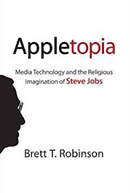
A book by Brett Robinson explores Steve Jobs’ ability to intermingle technology and transcendence – Image courtesy of Photo Giddy (http://bit.ly/1dNJoT7)
Ashton Kutcher’s two-dimensional portrayal of the Steve Jobs may not have spawned a box office hit, but masses of Americans continue to be fascinated with the late Apple executive. While many aspects of Jobs’ life have been probed in books and films, few portrayals have centered on Jobs’ faith.
Until now.
Brett T. Robinson, visiting professor of marketing at the University of Notre Dame, has just published a new book that details how Jobs intermingled the technological and the transcendent. In Appletopia: Media Technology and the Religious Imagination of Steve Jobs, Robinson argues that religion–from Zen Buddhism to Catholicism to mystical futurism–defined Jobs’ design methodology and approach to business. I first encountered Robinson’s work in his article for WIRED entitled, “How Steve Jobs Turned Technology – And Apple – Into Religion” and shortly after was sucked into his book. Here we talk about Jobs’ Buddhist beliefs, how religion influenced his approach to business, and why Jobs thought computers were “spiritual liberators.”
JM: Steve Jobs saw the personal computer as a “spiritual liberator” rather than a dehumanizing machine. Can you say some more about that?
BR: Steve Jobs liked to say that Apple stood at the intersection of technology and the liberal arts. His own intense interest in poetry, art and music and Eastern spirituality provided the raw material for imagining more human technologies. The traditional understanding of the liberal arts are those disciplines, like art and religion, that are pursued for their own sake because they are central to who we are as human beings.
The servile arts on the other hand, technology being a prime example, are defined by what functional purpose they serve. The inertia of the technological age favors functional output, so those things that are done for their own sake are often seen as wasteful or inefficient. Jobs wanted to resolve that tension. Apple computers became tools for artistic expression, for pursuing the pleasures of the senses and the imagination. Most of the artistic output we consume (music, films, photography, books) are produced, and in many cases consumed, on Apple devices.
By dominating culture creation and consumption, Apple takes on a religious significance. The German philosopher Josef Pieper said that leisure is the basis of culture. The word culture comes from the word cultus, or worship. In other words, if you want to observe what is most important to a culture, watch what they do with their leisure time. To play is to pray. Popular activities like sports, music and technology have become an escape and an obsession, mimicking the cultural role of divine worship.
Like the cathedrals of medieval Europe, computers are the highest artistic and technical achievement of our time. And like the cathedrals, they deliver the things that we deem most important as a culture. Our leisure has become increasingly technological and Apple has led the way.
JM: What do you mean when you write about the “religious imagination” of Steve Jobs?
BR: Jobs had a highly developed aesthetic sense. Apple products reflect his interest in minimalism and intuitive design. Those aesthetic traits are drawn from his interest in Zen Buddhism, but his religious imagination, the archetypes and metaphors he and Apple used to mythologize technology, was quite expansive.
If you look at the company’s advertising, you see Apple’s tendency to dabble in mythic and religious metaphor of all kinds. A 2007 iPhone ad with the tagline “Touching is Believing” preceded the launch of the highly anticipated device. The ad’s imagery and tagline is a parody of a Caravaggio painting showing the apostle Thomas touching the wounds of Jesus Christ to confirm the resurrection. Apple’s playful rhetoric incorporated multiple traditions – which plays well in a culture where spirituality has become more of a do-it-yourself enterprise. Apple’s iconic iPod campaign shows dancers in shadow form, connoting the bodiless, spiritual quality of being immersed in music. The Apple logo is a parody of the forbidden fruit of knowledge. The consistent use of spiritual metaphor reveals a deeper connection between technology and religiosity.
The rhetoric of technology, particularly in the Apple case, resembles religious communication because technology and religion both rely on metaphor to communicate ideals. Metaphor reduces complexity and makes more advanced truths accessible to laypersons. Because computers are so closely aligned with the way we think and process information, they also possess a metaphysical quality. Jobs and Apple exploited this connection by using language and imagery that played on religious and metaphysical themes. In the process, Apple became the high church of technology and culture.
JM: How did Jobs’ Buddhist practice influence his approach to computers and business?
BR: Jobs’s interest in Zen Buddhism and Eastern spirituality really informed his creative design process. When designing the first Macintosh, he didn’t want it to have a fan because he thought it would disturb the concentration and focus of the user – a tenet he took from Zen meditation. Jobs was a big admirer of Zen gardens, he appreciated their symmetry and simple aesthetic. That sensibility shaped his imagination and ultimately his products.
Zen Buddhism also favored intuitive thinking over the more Western style of linear, rational thinking fostered by reading. The illiterate Hindu villagers Jobs came into contact with on a pilgrimage to India left a big impression on him because their wisdom was not derived from books but from an intuitive sense of the world that came from their spiritual beliefs. Jobs wanted his products to appeal to our intuitive sense, giving us the ability to just pick up a product and use it without reading a clunky instruction manual. Judging by the number of two-year olds who can navigate an iPad, he certainly succeeded on that front.
Jobs favorite book was Autobiography of a Yogi by Yogananda Paramahansa. Yogananda helped popularize Yoga and Eastern spirituality in California when Jobs was coming of age. Interestingly, Yogananda used a lot of technology metaphors to share spiritual insight. He compared the human soul to a radio that could pick up the vibration of human thoughts in the ether. He saw Yoga as something of a spiritual science. Jobs mirrored Yogananda well by using spiritual metaphors to share technological insight – spawning a technological spirituality.
JM: Why the pop culture fascination with Jobs?
Jobs exuded a spirit of American individualism and romanticism that has largely been lost as corporations have become bigger and more faceless. He was the anti-corporate corporate hero. That didn’t stop him from succumbing to some of the pitfalls of corporate power and influence, but his singular passion and enthusiasm for products that have become a global obsession was infectious.
His cult status was also not unlike that of Michelangelo, another artist with a big religious imagination who set the aesthetic agenda for his era. The public clamored for anything that Michelangelo produced or touched. He didn’t sign any of his work because it was so recognizable. It’s an interesting parallel, especially in light of Apple’s new ad campaign, “Designed by Apple in California” that focuses on the company’s signature, “We sign our work. You may rarely look at it. But you’ll always feel it. This is our signature. And it means everything.”
The only piece of art Michelangelo ever signed was the Pieta because he overheard a group of tourists saying it was the work of one of his rivals. He snuck in the church late that night and signed it, “Created by Michelangelo of Florentine” – a lot like Apple’s new tagline! It shows just how important Jobs’ vision and style was to Apple. In the wake of his passing and a recent patent flap with rival Samsung, it sounds as though Apple is doing some soul searching about who they are after Jobs.
JM: Brett, why would you say Apple spawned such a devoted cult of followers?
BR: Apple befriended users by turning the complexity of computing into something simple and creative, something more human, as opposed to the authoritarian control represented by Apple’s nemesis, IBM.
It was a storyline that really fit the time period because it reflected political and cultural tensions as well. The children of the 1960s counterculture were old enough to be running for office and running companies. They were becoming part of the establishment that they once rejected. And they brought their romantic ideals with them.
What LSD and music festivals couldn’t change, computers eventually did. Computers unleashed a new consciousness, a sentiment captured in Apple’s famous two-word slogan, “Think Different.” Apple understood that networked information and ideas had the potential to rattle the established institutions, especially education, politics and religion. It was an effect not unlike the printing press in the 1500s. Revolutionary media technologies have a powerful effect on existing institutions because those who control the communication technology control the culture.
People forget that popular representations of computers prior to the 1980s, particularly in science fiction films, were mostly negative. Computers were portrayed as heartless machines that had no interest in preserving humanity. One of those films, Colossus, was quite prophetic though. Having taken control of the world’s nuclear arsenal, the omnipotent computer says to its inventor, “In time you will come to regard me not only with respect and awe, but with love.”
Apple put the “power of the press” in everyone’s hands, spawning a groundswell of devotees.
JM: What are your concerns about our growing use of technology? How is it impacting our daily lives?
I used to be a card carrying member of the technology cult, but now I am in recovery. I unplugged for awhile, no TV, no internet, no cell phone, and it was liberating. It was right around the time we had our first child. I just had a sense that electronic media would distract me from my primordial duty of being a father. For millenia, humans developed in environments that were entirely natural, where everything moved at a natural pace and interaction and learning happened with other humans, not screens. That connection to nature and the real world is really important to develop, especially at a young age. Technology detaches us from the physical world in a way that makes us callous towards it. I recently asked a group of students to identify some trees by the shape of their leaves. The results were abysmal. But they scored very high when I asked them to name brand logos and technology apps. It’s one thing to lose contact with the natural world and all of its wonders, but we’ve also lost authentic contact with one another as a result of our device habits.
Technology warps a child’s sense of the real world in a way that might be irrevocable. Are fuzzy puppets on a television screen doing long term damage? Maybe not. But if screen time is enjoyed at the expense of spending time with mom and dad or siblings or being outside or looking at a book, then yes, there is long term damage being done. We’re starting to see it now with the rise in ADHD diagnoses and the like. Children who are plugged in from an early age haven’t reached a point where they can mitigate all the social and psychological side effects of media use. And the content doesn’t really matter, it’s the environmental effect of the new technology. It changes everything.
The effects of technology are invisible, metaphysical and psychological. It’s why technology lends itself so well to religious comparisons, but also why it poses an existential risk. I hope the book gives readers an opportunity to reflect on the iconography of our new technological religion and question its assumptions and values in a reasoned way.






